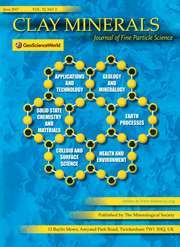Article contents
Examination of four coarsely crystalline chlorites by X-ray and high-pressure d.t.a. techniques
Published online by Cambridge University Press: 14 March 2018
Abstract
Because chlorite represents the highest order of mineral having a montmorillonite-illite like structure, it has been studied by the d.t.a. technique in water vapour atmospheres at pressures (absolute) in the range 0·001 mm of Hg to 2300 mm of Hg. The range of water vapour pressure makes profound changes in the thermograms, showing the very complex nature of the breakdown of the brucite-like layer which was not anticipated by other tests. The chlorite exotherm at 870°C can be completely suppressed by high pressure water vapour or can be greatly intensified by running in vacuum. The great differences in thermograms cannot be explained by chemical analyses or optical properties.
- Type
- Research Article
- Information
- Copyright
- Copyright © The Mineralogical Society of Great Britain and Ireland 1955
References
- 2
- Cited by


